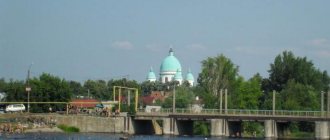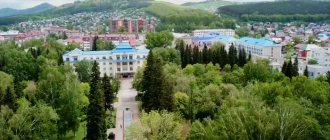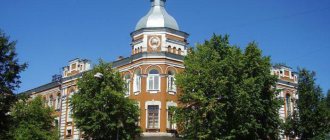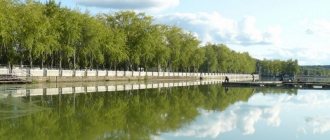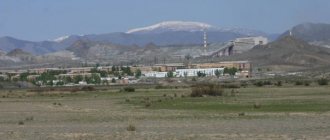Baymak city bashk. Bayma Country
|
Audio, photo and video
on Wikimedia Commons
K: Settlements founded in 1748
Baymak
(Bashk. Baymaҡ (inf.)) is a city in the Republic of Bashkortostan of the Russian Federation, the administrative center of the Baymaksky district of Bashkortostan.
Story
The name of the city comes from the name of Baymak Bikbulatov, a foreman who was an active participant in the Bashkir uprising of 1755.
Tanalykovo-Baymak was founded in 1748 as the ore base of the Kananikolsky and Preobrazhensky copper smelters. The original name came from the Tanalyk River.
After the suppression of the Bashkir uprising in 1755, the settlement was burned by the tsarist troops, and ore mining stopped at the same time. The rebirth of the village of Tanalykovo-Baymak is associated with the discovery in the mid-19th century of placer gold deposits on the Tanalyk River. During this period, in connection with the discovery of gold mines on this river by the industrialist Zhukov, the mass settlement of Baymak by Russians began. The owners of the mine were the Goryaevs, Andreevs, Kabanovs and the English.
On November 7, 1917, the Revolutionary Committee and the Council of Workers' Deputies were elected in Baymak, Leonid Azanov became its chairman. Tanalykovo-Baymak in 1922 became the center of the Burzyan-Tanalyk volost. In 1928, the settlement was transformed into a workers' settlement. In 1938, Baymak received the status of a city of district significance, and in 1992 - a city of republican significance. In 1954 it was supposed to become part of the never-formed Magnitogorsk region. In March 1994, by decree of the President of the Republic of Belarus, the city and district became a single territorial-administrative unit.
Notes
- ↑ 12
Population of the Russian Federation by municipalities as of January 1, 2022 (Russian). Date accessed: October 17, 2022. Archived October 17, 2022. - Law of the Republic of Bashkortostan dated December 17, 2004 No. 126-z “On the borders, status and administrative centers of municipalities in the Republic of Bashkortostan”
- At the turn of the century
- List of populated places in the Orenburg province 1871. P.44
- Lists of populated places in the Orenburg province, with general information about it. Orenburg, 1892
- Lists of populated places in the Orenburg province in 1901. C.63
- ↑ 12
Alphabetical list of populated places in the Orenburg province according to the agricultural and land census of 1917. P.17 - ↑ 1 2 3 4 5 6 7 8 9 10 11 12
People's Encyclopedia “My City”.
Baymak (undefined)
. Retrieved October 8, 2013. Archived October 9, 2013. - ↑ 1 2 3 4
I. Z. Samsitdinov.
Population of small towns of the Bashkir Autonomous Soviet Socialist Republic in 1943-1945. The process of re-evacuation and its consequences. Journal “News of the Russian State Pedagogical University named after. A.I. Herzen", No. 123, 2010 (unspecified)
. Retrieved January 2, 2015. Archived January 2, 2015. - All-Union Population Census of 1959. The size of the urban population of the RSFSR, its territorial units, urban settlements and urban areas by gender (Russian). Demoscope Weekly. Access date: September 25, 2013. Archived April 28, 2013.
- All-Union Population Census of 1970 The size of the urban population of the RSFSR, its territorial units, urban settlements and urban areas by gender. (Russian). Demoscope Weekly. Access date: September 25, 2013. Archived April 28, 2013.
- All-Union Population Census of 1979 The size of the urban population of the RSFSR, its territorial units, urban settlements and urban areas by gender. (Russian). Demoscope Weekly. Access date: September 25, 2013. Archived April 28, 2013.
- All-Union population census of 1989. Urban population (undefined)
. Archived from the original on August 22, 2011. - All-Russian population census 2002. Volume. 1, table 4. Population of Russia, federal districts, constituent entities of the Russian Federation, districts, urban settlements, rural settlements - regional centers and rural settlements with a population of 3 thousand or more (unspecified)
. Archived from the original on February 3, 2012. - 1.5. Population of the Republic of Bashkortostan by municipalities as of January 1, 2009
- The size of the permanent population of the Russian Federation by cities, urban-type settlements and regions as of January 1, 2009 (unspecified)
. Retrieved January 2, 2014. Archived January 2, 2014. - All-Russian population census 2010. Population by settlements of the Republic of Bashkortostan (unspecified)
. Retrieved August 20, 2014. Archived August 20, 2014. - Population of the Russian Federation by municipalities. Table 35. Estimated resident population as of January 1, 2012 (unspecified)
. Retrieved May 31, 2014. Archived May 31, 2014. - Population of the Russian Federation by municipalities as of January 1, 2013. - M.: Federal State Statistics Service Rosstat, 2013. - 528 p. (Table 33. Population of urban districts, municipal districts, urban and rural settlements, urban settlements, rural settlements) (undefined)
. Retrieved November 16, 2013. Archived November 16, 2013. - Table 33. Population of the Russian Federation by municipalities as of January 1, 2014 (unspecified)
. Access date: August 2, 2014. Archived August 2, 2014. - Population of the Russian Federation by municipalities as of January 1, 2015 (unspecified)
. Access date: August 6, 2015. Archived August 6, 2015. - Population of the Russian Federation by municipalities as of January 1, 2016 (Russian) (October 5, 2018). Retrieved May 15, 2022. Archived May 8, 2022.
- Population of the Russian Federation by municipalities as of January 1, 2022 (Russian) (July 31, 2017). Retrieved July 31, 2022. Archived July 31, 2022.
- Population of the Russian Federation by municipalities as of January 1, 2022 (Russian). Retrieved July 25, 2018. Archived July 26, 2022.
- Population of the Russian Federation by municipalities as of January 1, 2022 (Russian). Retrieved July 31, 2019. Archived May 2, 2022.
- taking into account the cities of Crimea
- https://rosstat.gov.ru/storage/mediabank/bul_Chislen_nasel_MO-01-01-2021.rar Population of the Russian Federation by municipalities as of January 1, 2022 (1.85 Mb, 07/30/2021)
- Results of the 2010 All-Russian Population Census for the Republic of Bashkortostan Archived on March 9, 2013.
- ↑ 1 2 3 4 5 6 Our Ural.
Baymak Museum of History and Local Lore (Russian)
(undefined)
.
Our Ural
(November 22, 2021). Date accessed: December 29, 2022. - Our Ural.
The house of an old man in the village of Bakhtigareevo, Baymaksky district (Russian)
(undefined)
.
Our Ural
(November 22, 2021). Date accessed: December 29, 2022. - Our Ural.
Sights of the Baymaksky district: Irendyk ridge (Russian)
(undefined)
.
Our Ural
(September 3, 2021). Date accessed: December 29, 2022. - Our Ural.
Sights of the Baymaksky district: Lake Talkas (Russian)
(undefined)
.
Our Ural
(September 6, 2021). Date accessed: December 29, 2022. - Our Ural.
Baymaksky district: the Shugur river and a bathhouse complex in the mountains (Russian)
(undefined)
.
Our Ural
(September 17, 2021). Date accessed: December 29, 2022. - Our Ural.
Sights of the Baymaksky district: Grafskoye Lake (Russian)
(undefined)
.
Our Ural
(October 12, 2021). Date accessed: December 29, 2022.
Population
| Population | |||||
| 1931[2] | 1939[2] | 1944[3] | 1945[3] | 1946[3] | 1947[3] |
| 6100 | ↗13 900 | ↗21 000 | ↘19 600 | ↗19 900 | ↗20 200 |
| 1959[4] | 1970[5] | 1979[6] | 1989[7] | 1992[2] | 1996[2] |
| ↘11 335 | ↗12 467 | ↗13 453 | ↗15 976 | ↗16 800 | ↗17 500 |
| 1998[2] | 2000[2] | 2001[2] | 2002[8] | 2003[2] | 2005[2] |
| →17 500 | ↘17 100 | ↘16 900 | ↗17 223 | ↘17 200 | ↘17 100 |
| 2006[2] | 2007[2] | 2008[9] | 2009[10] | 2010[11] | 2011[2] |
| ↘16 900 | ↘16 800 | ↗16 932 | ↗17 069 | ↗17 710 | ↘17 700 |
| 2012[12] | 2013[13] | 2014[14] | 2015[15] | 2016[1] | |
| ↘17 608 | ↘17 534 | ↘17 492 | ↘17 460 | ↗17 475 | |
National composition
According to the 2010 All-Russian Population Census: Bashkirs - 71.6%, Russians - 21.3%, Tatars - 5.1%, people of other nationalities - 2% [16]
Social sphere
Education
- Secondary educational school No. 1
- Secondary educational school No. 2
- Secondary educational school No. 3
- Lyceum No. 4
- Baymak Lyceum - boarding school
- Professional Lyceum No. 105
- Baymak Agricultural College
- Ufa Fuel and Energy College, Baymaksky branch
- Children's art school
Culture and recreation
- Park of Culture and Leisure named after. S. Yulaeva
- District House of Culture
- Cinema "Irendyk"
- Tourist base "Count Lake"
- Sanatorium "Talkas"
Hotels
- Hotel "Bashkiria"
- Hotel "Sakmar"
- Camping "Ilsebika-Tau"
Baths and saunas
- City bath
Literature
- Baymak // Great Russian Encyclopedia: [in 35 volumes] / ch. ed. Yu. S. Osipov. — M.: Great Russian Encyclopedia, 2004—2017.
- M.F. Khismatov.
Baymak // Bashkir Encyclopedia / ch. ed. M. A. Ilgamov. - Ufa: GAUN "Bashkir Encyclopedia", 2015-2020. — ISBN 978-5-88185-306-8. - Baymak Encyclopedia / Scientific ed. board: I. Kh. Sitdikov (chairman), K. I. Agliullina, A. Z. Asfandiyarov and others - Ufa: Bashkir Encyclopedia, 2013. - 640 p. — 3100 copies. — ISBN 978-5-88185-084-5. (in translation)
Monuments
- Monument to those killed during the Great Patriotic War. Located at the western bridge near the foundry and mechanical plant.
Monument. Located near the city administration.- A monument to the fallen Red Army soldiers during the Civil War, there is also a grave of 10 fallen Red Army soldiers. Located on Lenin Street, not far from Chernyshevsky Street.
Mass media
A television
- First channel;
- Russia 1;
- Russia K;
- BST;
- Match TV;
- TV Center;
- Baymak-TV;
Radio
- 67.16 MHz Radio Russia;
- 100.3 MHz Europe plus;
- 101.2 MHz Autoradio;
- 102.7 MHz Radio Yuldash;
- 106.3 MHz Satellite FM;
- 104.5 MHz Traffic radio;
- 107.6 MHz NRJ;
Printed publications
- Newspaper "Khamar";
- Newspaper "Baymakskiy Vestnik";
- Advertising and information newspaper "Baymak-info".
A city in which 2 different buildings have the same address: 1. State budgetary institution Integrated Center for Social Services for the Population of the Baymak District, Baymak, Republic of Bashkortostan, Mira St., 1; 2. Rosselkhozbank st. Mira, 1, Baymak, Republic of Bashkortostan.
Head of Administration
There are 22 rural settlements and one urban settlement in the Baymaksky district. There are also villages here. The head of the administration is Ilshat Khamitovich Sitdikov. He has been in office relatively recently - since 2011. But he has already made many positive changes to his brainchild. First of all, a colossal amount of work is being done to repair and build roads, education is being developed, and many efforts are being made to preserve the cultural heritage of the area. The head of administration has concluded many contracts and successfully cooperates with investors. For example, wood processing is underway with one large company, and under the Gazprom program, a huge inter-settlement gas pipeline is being built, which will supply a large area with natural gas.
Excerpt characterizing Baymak
“La mort est secourable et la mort est tranquille “Ah! contre les douleurs il n'y a pas d'autre asile.” [Death is salutary and death is calm; ABOUT! there is no other refuge against suffering.] Julie said it was lovely. “II ya quelque chose de si ravissant dans le sourire de la melancolie, [There is something infinitely charming in the smile of melancholy," she said to Boris word for word, copying this passage from the book. – C'est un rayon de lumiere dans l'ombre, une nuance entre la douleur et le desespoir, qui montre la consolation possible. [This is a ray of light in the shadows, a shade between sadness and despair, which indicates the possibility of consolation.] - To this Boris wrote her poems: “Aliment de poison d'une ame trop sensible, “Toi, sans qui le bonheur me serait impossible, "Tendre melancolie, ah, viens me consoler, "Viens calmer les tourments de ma sombre retraite "Et mele une douceur secrete "A ces pleurs, que je sens couler." [Poisonous food of an overly sensitive soul, You, without whom happiness would be impossible for me, Tender melancholy, oh, come, comfort me, Come, soothe the pangs of my gloomy solitude, And add a secret sweetness To these tears that I feel flowing.] Julie played the saddest nocturnes on the harp for Boris. Boris read Poor Liza aloud to her and more than once interrupted his reading from the excitement that took his breath away. Meeting in a large society, Julie and Boris looked at each other as the only indifferent people in the world who understood each other. Anna Mikhailovna, who often went to the Karagins, making up her mother’s party, meanwhile made correct inquiries about what was given for Julie (both Penza estates and Nizhny Novgorod forests were given). Anna Mikhailovna, with devotion to the will of Providence and tenderness, looked at the refined sadness that connected her son with the rich Julie. “Toujours charmante et melancolique, cette chere Julieie,” she said to her daughter. - Boris says that he rests his soul in your house. “He has suffered so many disappointments and is so sensitive,” she told her mother. “Oh, my friend, how attached I have become to Julie lately,” she said to her son, “I can’t describe to you!” And who can not love her? This is such an unearthly creature! Ah, Boris, Boris! “She fell silent for a minute. “And how I feel sorry for her maman,” she continued, “today she showed me reports and letters from Penza (they have a huge estate) and she is poor, all alone: she is so deceived! Boris smiled slightly as he listened to his mother. He meekly laughed at her simple-minded cunning, but listened and sometimes asked her carefully about the Penza and Nizhny Novgorod estates. Julie had long been expecting a proposal from her melancholic admirer and was ready to accept it; but some secret feeling of disgust for her, for her passionate desire to get married, for her unnaturalness, and a feeling of horror at renouncing the possibility of true love still stopped Boris. His vacation was already over. He spent whole days and every single day with the Karagins, and every day, reasoning with himself, Boris told himself that he would propose tomorrow. But in the presence of Julie, looking at her red face and chin, almost always covered with powder, at her moist eyes and at the expression of her face, which always expressed a readiness to immediately move from melancholy to the unnatural delight of marital happiness, Boris could not utter a decisive word: despite the fact that for a long time in his imagination he considered himself the owner of Penza and Nizhny Novgorod estates and distributed the use of income from them. Julie saw Boris's indecisiveness and sometimes the thought occurred to her that she was disgusting to him; but immediately the woman’s self-delusion came to her as a consolation, and she told herself that he was shy only out of love. Her melancholy, however, began to turn into irritability, and not long before Boris left, she undertook a decisive plan. At the same time that Boris's vacation was ending, Anatol Kuragin appeared in Moscow and, of course, in the Karagins' living room, and Julie, unexpectedly leaving her melancholy, became very cheerful and attentive to Kuragin. “Mon cher,” Anna Mikhailovna said to her son, “je sais de bonne source que le Prince Basile envoie son fils a Moscou pour lui faire epouser Julieie.” [My dear, I know from reliable sources that Prince Vasily sends his son to Moscow in order to marry him to Julie.] I love Julie so much that I would feel sorry for her. What do you think, my friend? - said Anna Mikhailovna. The thought of being a fool and wasting this whole month of difficult melancholy service under Julie and seeing all the income from the Penza estates already allocated and properly used in his imagination in the hands of another - especially in the hands of the stupid Anatole, offended Boris. He went to the Karagins with the firm intention of proposing. Julie greeted him with a cheerful and carefree look, casually talked about how much fun she had at yesterday's ball, and asked when he was leaving. Despite the fact that Boris came with the intention of talking about his love and therefore intended to be gentle, he irritably began to talk about women's inconstancy: how women can easily move from sadness to joy and that their mood depends only on who looks after them. Julie was offended and said that it was true that a woman needs variety, that everyone will get tired of the same thing. “For this, I would advise you...” Boris began, wanting to tell her a caustic word; but at that very moment the offensive thought came to him that he could leave Moscow without achieving his goal and losing his work for nothing (which had never happened to him). He stopped in the middle of his speech, lowered his eyes so as not to see her unpleasantly irritated and indecisive face and said: “I didn’t come here at all to quarrel with you.” On the contrary...” He glanced at her to make sure he could continue. All her irritation suddenly disappeared, and her restless, pleading eyes were fixed on him with greedy expectation. “I can always arrange it so that I rarely see her,” thought Boris. “And the work has begun and must be done!” He blushed, looked up at her and told her: “You know my feelings for you!” There was no need to say any more: Julie’s face shone with triumph and self-satisfaction; but she forced Boris to tell her everything that is said in such cases, to say that he loves her, and has never loved any woman more than her. She knew that she could demand this for the Penza estates and Nizhny Novgorod forests and she received what she demanded. The bride and groom, no longer remembering the trees that showered them with darkness and melancholy, made plans for the future arrangement of a brilliant house in St. Petersburg, made visits and prepared everything for a brilliant wedding. Count Ilya Andreich arrived in Moscow at the end of January with Natasha and Sonya. The Countess was still unwell and could not travel, but it was impossible to wait for her recovery: Prince Andrei was expected to go to Moscow every day; in addition, it was necessary to purchase a dowry, it was necessary to sell the property near Moscow, and it was necessary to take advantage of the presence of the old prince in Moscow to introduce him to his future daughter-in-law. The Rostovs' house in Moscow was not heated; in addition, they arrived for a short time, the countess was not with them, and therefore Ilya Andreich decided to stay in Moscow with Marya Dmitrievna Akhrosimova, who had long offered her hospitality to the count. Late in the evening, four of the Rostovs' carts drove into Marya Dmitrievna's yard in the old Konyushennaya. Marya Dmitrievna lived alone. She has already married off her daughter. Her sons were all in the service. She still held herself straight, she also spoke directly, loudly and decisively to everyone her opinion, and with her whole being she seemed to reproach other people for all sorts of weaknesses, passions and hobbies, which she did not recognize as possible. From early morning in the kutsaveyka, she did housework, then went: on holidays to mass and from mass to prisons and prisons, where she had business that she did not tell anyone about, and on weekdays, after getting dressed, she received petitioners of different classes at home who came to her every day, and then had lunch; There were always about three or four guests at the hearty and tasty dinner; after dinner I made a round of Boston; At night she forced herself to read newspapers and new books, and she knitted. She rarely made exceptions for trips, and if she did, she went only to the most important people in the city.

